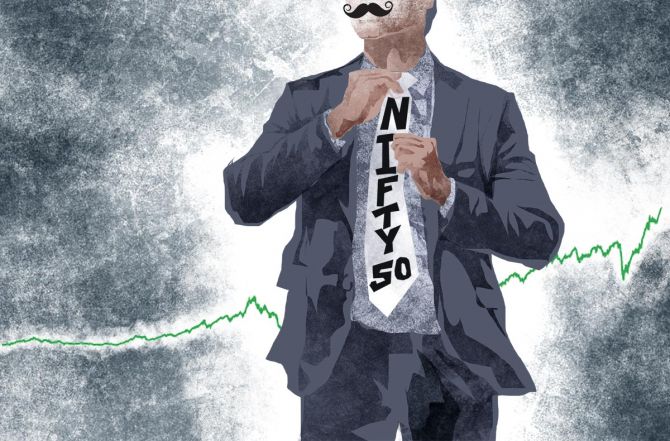While Nifty 50 reflects changes in 40 years, it also shows what is missing: Low-cost manufacturers at one end, and deep-value players at the other.
Also missing are technology players, observes T N Ninan

Forty years ago, the combined value on the stock market of the listed companies belonging to the 30 largest business 'houses' was Rs 6,200 crore (Rs 62 billion).
GDP at the time was 28 times bigger (Rs 1.75 lakh crore).
Most of the companies were in 'primary' manufacturing: Jute, tea, cement, sugar, steel fabrication, textiles. There has been dramatic change since then.
The combined value of companies listed on the National Stock Exchange today is about 15 per cent more than GDP, which last year was Rs 197 trillion.
Strangely, the power of the 'big monopoly' houses (seen from today's perspective as having been tiny) was a hot political issue back then.
Whereas today wealth creation through these companies is celebrated because many more retail investors have been brought in through the stock market and mutual funds; the business media have more of a voice; and there is only muted talk of the political control exercised by leading businessmen.
This legitimisation of capitalism (and, it seems, of crony capitalism too) has occurred in slow stages.
There was first a turning away from State capitalism. The last major bouts of nationalisation were in the early 1980s -- banks, Bombay's textile mills and Calcutta's engineering units -- and delivered poor results.
The decades of the 1980s and 1990s were a period of endless business controversy, even shaking up national politics, but Ambani and subsequently Adani has emerged unscathed.
They and others like them seem to get their way with the government, and criticism seems futile.
Meanwhile, there was reform: Delicensing, new sectors allowed to private enterprise, and foreign investment.
There was churn within the private sector. Many who could not cope with the change disappeared or became irrelevant -- like the Mafatlals, Khaitans, Thapars, Modis and Sarabhais.
In their place came the new stars from the worlds of finance and technology services, pharmaceuticals and auto. The stock market today reflects the results of these trends.
Of the 50 stocks in the Nifty 50 index, 11 are of companies in financial services, six in the auto sector, five in IT services and four in pharmaceuticals, while seven from the public sector are in energy.
Outside of auto, manufacturing finds poor representation. And few conglomerate business houses remain; the Nifty has space for Tata (four companies), Birla (2), Ambani (1) and Adani (1). This is a world away from what existed in 1981.
But while Nifty 50 reflects change, it also shows what is missing: Low-cost manufacturers at one end, and at the other quality, deep-value players such as the companies that dominate Germany's Dax 30 (BASF, Daimler, Siemens) or the French CAC 40 (Airbus, Schneider and Thales, apart from luxury purveyors like LVMH and Hermes).
Also missing in Nifty are cutting-edge technology players of the kind that have re-invented the world and dominate Nasdaq in the US.
Britain, no longer a manufacturing power, reflects in its FTSE 100 the country's transition to finance, consumer brands and retailing, while energy and pharmaceuticals are the primary technology hold-outs.
Japan, the 'Western' world's largest economy after the US, has in the Nikkei 225 a broader index, which therefore has a mix of almost everything.
China on its part has barely begun the climb up the value-addition ladder with its Internet-based and high-speed rail companies.
The Shanghai Composite has its fair share of finance, construction, pharma and auto companies, plus contract manufacturers like Foxconn.
While stock market indices hold up a mirror to the changed reality, they don't show the full picture -- partly because large unlisted and often foreign-owned companies like Hyundai and Coca-Cola don't get counted.
Meanwhile, in Business Standard's list of the 1,000 largest listed companies (ranked by sales, not stock market value), the largest categories include capital goods, textiles and garments, auto ancillaries, steel, pharmaceuticals and technology software.
The largest in the textiles-garments category (Arvind) is ranked a lowly 148th, with modest sales of Rs 7,360 crore (Rs 73.60 billion).
Technology hardware as a category does not exist. Most of the new innovation-driven unicorns too are in technology-enabled services.
Feature Presentation: Rajesh Alva/Rediff.com












 © 2025
© 2025